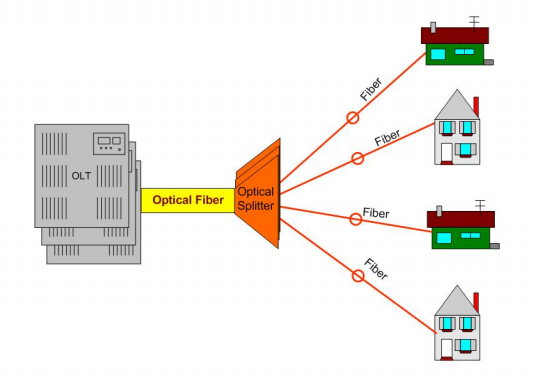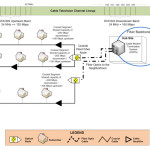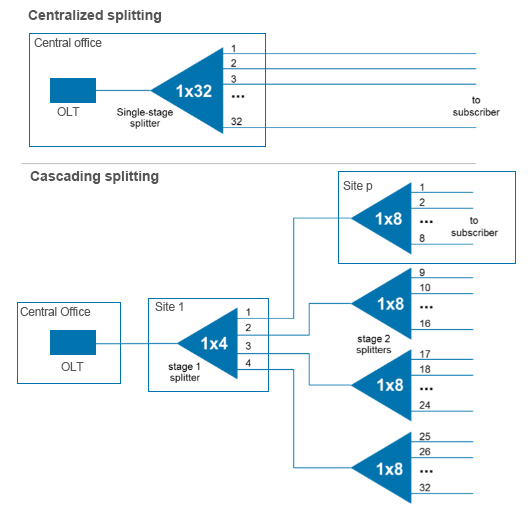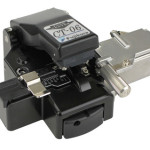HFC and FTTH networks differ in that HFC extends fiber to a node within a mile of the home or business, while FTTH extends fiber all the way to the home or business—typically terminating the fiber at a customer premises device, which then provides service to devices in the home over copper lines, coaxial cable, or wireless connections. As a result, FTTH networks have greater capacity and significant functional benefits over HFC networks. However, HFC can scale in capacity, both through expansion of fiber and upgrading of electronics, and HFC provides a logical evolution path for the hundreds of millions of homes and businesses connected by the technology to gradually reach gigabit speeds.
Because of the properties of fiber optics and the capabilities and scalability of fiber optic electronics, FTTH provides many capabilities that HFC cannot provide. Among current communications technologies, only fiber has the “off-the-shelf” capacity to support gigabit and higher speeds to the majority of users on a network. FTTH is also the only technology with the option of high-speed symmetrical services. At the root of the difference is the superior physical capacity of a fiber optic strand, as compared with coaxial cable.
As an example, inexpensive, off-the-shelf equipment used by Google Fiber and other providers can provide symmetrical 1 Gbps service. This is not feasible on an HFC system unless fiber has been extended almost all the way to the subscriber—and even then the service will not be symmetrical. A 1 Gbps cable service will not be a reality until DOCSIS 3.1 is introduced over the next few years, by which time the FTTH state of the art will be 10 Gbps or faster. Therefore, in any ‘greenfield’ setting, or where a telecommunications operator is not leveraging substantial legacy infrastructure, FTTH is the logical choice for a new wired broadband network.
With the cable lengths and components in a typical cable system, coaxial cable is limited to approximately 1 GHz of physical capacity (spectrum), and operators allocate this capacity with roughly 20 times as much downstream (network to user) as upstream (user to network). An additional limitation arises from the shared nature of cable modem service. Because bandwidth within a neighborhood is shared rather than dedicated, speeds may be significantly decreased by one’s neighbors’ simultaneous use of their cable modems.
So far, cable operators have found an effective work-around to address the limitations of coaxial cable — a strategy that can help them scale their services for the coming years while they selectively build fiber where demand is highest. This is to use progressively more advanced technologies and protocols over their coaxial cable and to selectively extend fiber backbones deeper into their networks.
The effect of expanding fiber is twofold:
1) Extending fiber reduces the number of homes and businesses sharing a segment of coaxial cable, thereby incrementally increasing the available capacity per customer.
2) Extending fiber reduces the accumulated effect of the limitations of coaxial cable in the system; with progressively shorter stretches of coaxial cable, the inherent problems with reliability and interference decrease.
For high-value locations (e.g., business parks, “power users,” and secure users such as banks, hospitals, and government), the cable operator may extend fiber all the way to the customer, often alongside the existing coaxial cable (thereby reducing the cost of construction relative to totally “new” construction). By pursuing this strategy, HFC systems can come within range of the capacity of FTTH systems without investing in substantial new cable construction.
Similar to HFC networks, central equipment in an FTTH network is housed at a central office (CO) or video headend office (VHO). From the CO, fiber optics extend directly to each customer premises, often with some type of intermediate device located near the customer to split or aggregate connections, depending on the specific technology chosen. For example, an FTTH network using PON technology would employ a passive optical splitter between the CO and the customer locations. The role of the splitter is to simply “split” the signal from the CO into individual customer signals, typically supporting either 32 or 64 customers per fiber strand .









